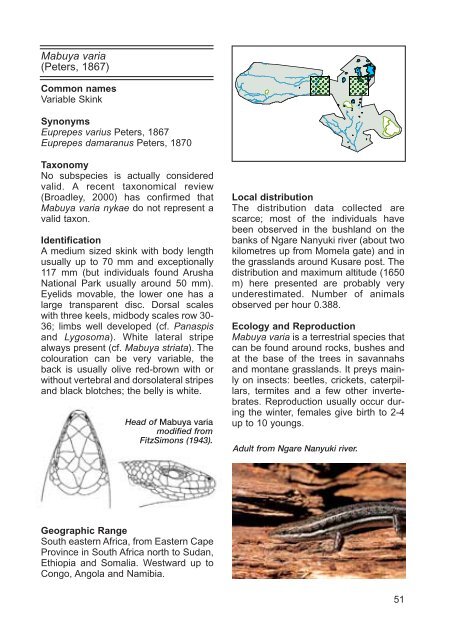field guide to the amphibians and reptiles of arusha national park
field guide to the amphibians and reptiles of arusha national park
field guide to the amphibians and reptiles of arusha national park
Create successful ePaper yourself
Turn your PDF publications into a flip-book with our unique Google optimized e-Paper software.
Mabuya varia<br />
(Peters, 1867)<br />
Common names<br />
Variable Skink<br />
Synonyms<br />
Euprepes varius Peters, 1867<br />
Euprepes damaranus Peters, 1870<br />
Taxonomy<br />
No subspecies is actually considered<br />
valid. A recent taxonomical review<br />
(Broadley, 2000) has confirmed that<br />
Mabuya varia nykae do not represent a<br />
valid taxon.<br />
Identification<br />
Amedium sized skink with body length<br />
usually up <strong>to</strong> 70 mm <strong>and</strong> exceptionally<br />
117 mm (but individuals found Arusha<br />
National Park usually around 50 mm).<br />
Eyelids movable, <strong>the</strong> lower one has a<br />
large transparent disc. Dorsal scales<br />
with three keels, midbody scales row 30-<br />
36; limbs well developed (cf. Panaspis<br />
<strong>and</strong> Lygosoma). White lateral stripe<br />
always present (cf. Mabuya striata). The<br />
colouration can be very variable, <strong>the</strong><br />
back is usually olive red-brown with or<br />
without vertebral <strong>and</strong> dorsolateral stripes<br />
<strong>and</strong> black blotches; <strong>the</strong> belly is white.<br />
Head <strong>of</strong> Mabuya varia<br />
modified from<br />
FitzSimons (1943).<br />
Geographic Range<br />
South eastern Africa, from Eastern Cape<br />
Province in South Africa north <strong>to</strong> Sudan,<br />
Ethiopia <strong>and</strong> Somalia. Westward up <strong>to</strong><br />
Congo, Angola <strong>and</strong> Namibia.<br />
Local distribution<br />
The distribution data collected are<br />
scarce; most <strong>of</strong> <strong>the</strong> individuals have<br />
been observed in <strong>the</strong> bushl<strong>and</strong> on <strong>the</strong><br />
banks <strong>of</strong> Ngare Nanyuki river (about two<br />
kilometres up from Momela gate) <strong>and</strong> in<br />
<strong>the</strong> grassl<strong>and</strong>s around Kusare post. The<br />
distribution <strong>and</strong> maximum altitude (1650<br />
m) here presented are probably very<br />
underestimated. Number <strong>of</strong> animals<br />
observed per hour 0.388.<br />
Ecology <strong>and</strong> Reproduction<br />
Mabuya varia is a terrestrial species that<br />
can be found around rocks, bushes <strong>and</strong><br />
at <strong>the</strong> base <strong>of</strong> <strong>the</strong> trees in savannahs<br />
<strong>and</strong> montane grassl<strong>and</strong>s. It preys mainly<br />
on insects: beetles, crickets, caterpillars,<br />
termites <strong>and</strong> a few o<strong>the</strong>r invertebrates.<br />
Reproduction usually occur during<br />
<strong>the</strong> winter, females give birth <strong>to</strong> 2-4<br />
up <strong>to</strong> 10 youngs.<br />
Adult from Ngare Nanyuki river.<br />
51

















